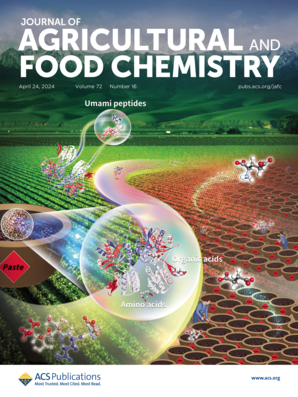杉木种子中具有抗真菌活性的异黄酮和芪类化合物
IF 5.7
1区 农林科学
Q1 AGRICULTURE, MULTIDISCIPLINARY
引用次数: 0
摘要
为了从天然产物中发现新的杀菌剂,对杉木热藓种子进行了深入的植物化学研究。采用生物测定法从杉木种子粗提物中分离得到8个新的异黄酮衍生物(1-5和8-10),2个新的二苯乙烯(6和7),以及21个已知的异黄酮(11-31)。通过HRESIMS、NMR、IR、UV和量子化学计算证实了1-31的结构。通过菌丝抑制试验,筛选了1-31对烟草疫霉、圆形炭疽菌、番茄丝核菌和灰霉病菌的抑菌活性。化合物6体外抑菌活性显著(EC50: 9.68 μg/mL),体内防治效果为8.5.7% (100 μg/mL)。此外,抗真菌机制研究表明,6在体外引起活性氧积累,增加脂质过氧化水平,降低MDH活性,最终引发分子损伤和细胞死亡。因此,6可以作为新型杀菌剂的先导化合物。本文章由计算机程序翻译,如有差异,请以英文原文为准。

Isoflavones and Stilbenes With Antifungal Activities From the Seeds of Thermopsis lanceolata R. Br
In order to discover novel fungicides from natural products, the phytochemical investigation of Thermopsis lanceolata seeds was thoroughly conducted. Eight new isoflavone derivatives (1–5 and 8–10), two new stilbenes (6 and 7), as well as 21 known isoflavones (11–31) were obtained from the crude extract of T. lanceolata seeds following a bioassay-guided method. The structures of 1–31 were confirmed via HRESIMS, NMR, IR, UV, and quantum chemistry calculations. The antifungal activities of 1–31 against Phytophthora nicotiana, Colletotrichum orbiculare, Rhizoctonia solani, and Botrytis cinerea were screened according to the mycelial inhibition test. Compound 6 displayed significant antifungal activity against B. cinerea in vitro (EC50: 9.68 μg/mL) and had an 8 5.7% prevention and control effect in vivo (100 μg/mL). Moreover, antifungal mechanism studies revealed that 6 causes the accumulation of reactive oxygen species, increases the level of lipid peroxidation, decreases the activity of MDH, and finally triggers molecular damage and cell death in vitro. Therefore, 6 can be utilized as a lead compound for novel fungicides.
求助全文
通过发布文献求助,成功后即可免费获取论文全文。
去求助
来源期刊
CiteScore
9.90
自引率
8.20%
发文量
1375
审稿时长
2.3 months
期刊介绍:
The Journal of Agricultural and Food Chemistry publishes high-quality, cutting edge original research representing complete studies and research advances dealing with the chemistry and biochemistry of agriculture and food. The Journal also encourages papers with chemistry and/or biochemistry as a major component combined with biological/sensory/nutritional/toxicological evaluation related to agriculture and/or food.

 求助内容:
求助内容: 应助结果提醒方式:
应助结果提醒方式:


